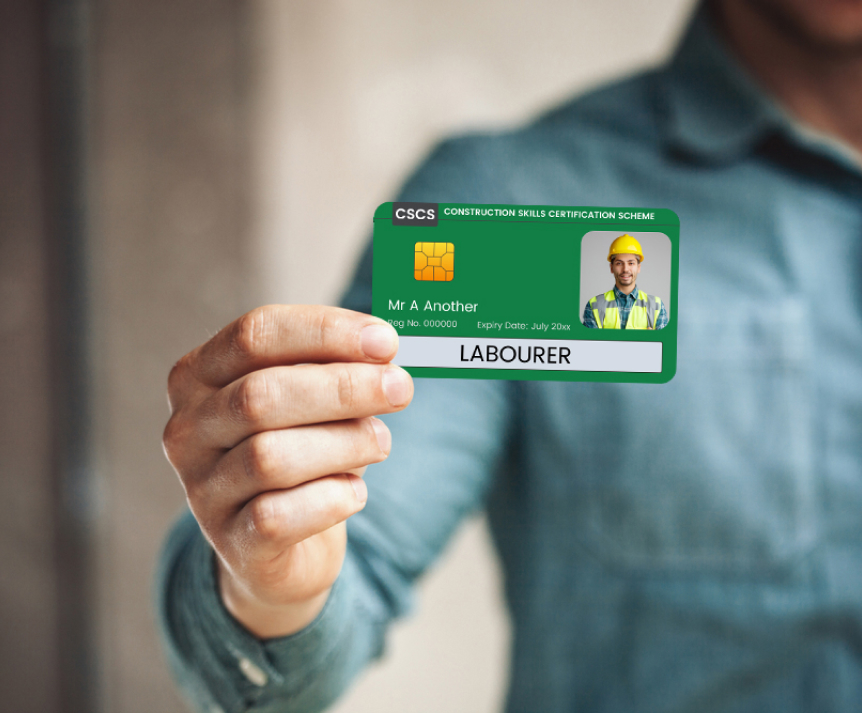In this blog post, we’ll explore the CSCS Blue Card, why it’s important, and what you need to get it. Whether you’re new to construction or have been in the industry for a while, understanding the CSCS Blue Card can help you in your job. So, let’s explore everything you need about this key certification for construction workers.
What is a Blue CSCS Card?
A Blue CSCS Card validates a construction worker’s expertise and competence in their specific trade within the construction industry. It proves they have undergone training and demonstrated proficiency in plumbing, bricklaying, or other specialised tasks. This card holds significant importance as it assures employers that the holder possesses the necessary skills and knowledge to perform their job effectively and safely.
Getting a Blue CSCS Card typically involves completing relevant training programmes and passing assessments tailored to the specific trade. Overall, the Blue CSCS Card is a valuable asset, enhancing employability and credibility within the construction sector.
What does a Blue Card mean in construction?
In construction, a Blue Card means the person holding it is skilled in a specific trade. It’s a sign that they have the right training and knowledge to do their job properly. For example, someone with a Blue Card for carpentry is good at building and fixing things with wood.
Employers look for workers with Blue Cards because they know they can rely on them to do quality work. So, having a Blue Card can open up more job opportunities in the construction industry.
What is the benefit of a Blue CSCS Card?
Holding a Blue CSCS Card in construction validates a worker’s skills and knowledge in a specific trade, such as plumbing, carpentry, or bricklaying. This certification enhances employability by demonstrating to employers that the cardholder has met industry standards and can perform tasks safely and effectively.
With a Blue CSCS Card, workers can access more job opportunities and earn higher wages due to their recognised expertise. Additionally, having this card may be required by employers or site managers to ensure compliance with health and safety regulations on construction sites.
What qualifications do I need for a Blue CSCS Card?
To get a Blue CSCS Card, you must demonstrate that you have the necessary qualifications and skills in a specific trade within the construction industry. The qualifications required can vary depending on the trade but generally include completing a recognised apprenticeship programme, vocational qualification, or a construction-related Level 2 NVQ/SVQ or SVQ at SCQF Level 5 specific to your trade.
To understand essential safety practices on construction sites, you must also pass the CITB Health, Safety & Environment Test for Operatives. Once you have met these requirements, you can apply for the card through the Construction Skills Certification Scheme (CSCS) or an affiliated certification provider.

How much does a Blue CSCS Card cost?
The application fee for a CSCS card remains consistent across types of CSCS cards, standing at £36.
However, getting a CSCS Blue Card involves additional expenses. These include the fee for obtaining a Level 2 NVQ/SVQ or SVQ at SCQF Level 5 qualification, which ranges from £300 to £1,000. Another cost is the CITB test, which costs £22.50. Combined with the CSCS Blue Card application fee (£36), these expenses estimate the overall cost of getting a CSCS card.
What is the difference between a Red and Blue CSCS Card?
The main difference between a Red and Blue CSCS Card lies in the level of qualification and expertise they represent. A Red CSCS Card is typically issued to individuals still undergoing training or working towards achieving a recognised construction-related qualification, such as an apprenticeship. It indicates that the holder is gaining the necessary skills and knowledge to work safely on construction sites but may still need to complete all the required training.
On the other hand, a Blue CSCS Card is granted to individuals who have attained a certain level of competence in a specific trade within the construction industry. This card signifies that the holder has completed the necessary training, achieved relevant qualifications (such as a Level 2 NVQ/SVQ or equivalent), and demonstrated proficiency in their chosen trade.
While a Red CSCS Card is more temporary and indicative of a learner or trainee status, a Blue CSCS Card represents a higher level of skill and readiness to work independently in construction.
Is a Blue CSCS Card good?
Yes, having a Blue CSCS Card is generally considered beneficial in the construction industry. Employers often prefer workers with a Blue CSCS Card because it assures them that the individual has undergone the necessary training and assessments to perform their job safely and effectively.
With a Blue CSCS Card, workers can access more job opportunities, earn higher wages, and demonstrate their credibility within the construction sector. Overall, getting a Blue CSCS Card is a positive achievement and can enhance one’s employability and prospects for career advancement in the construction industry.
Can I get a Blue CSCS Card without an NVQ?
The commonly preferred method to get a Blue CSCS Card without an NVQ is initially applying for a CSCS Red Card. Alongside this option, there are three alternative routes available:
- Obtaining a City & Guilds of London Institute Craft Certificate.
- Completing a Trailblazer Apprenticeship with CSCS Approval.
- Undertaking the Experienced Worker Practical Assessment (EWPA) or the On-Site Assessment (OSAT) route.
How to obtain a CSCS Blue Card?
There are three steps to obtain a CSCS Blue Card. However, you must have a valid CSCS Labourer Card before you apply for it.
Step 1: Complete Level 2 NVQ/SVQ
You must complete a construction-related Level 2 NVQ/SVQ or SVQ at SCQF Level 5. Alternatively, you can undergo an apprenticeship sponsored by an employer.
Step 2: Pass a CITB HS&E Test for Operatives
You must also pass the CITB Health, Safety & Environment Test for Operatives. At Hurak Learning, we help you reserve your CITB test. It’s recommended to take a CSCS Blue Card mock test for practice before attempting a CITB test.
Download our CITB Operatives and Specialists Test Prep Book for free!
×
Step 3: Apply for a CSCS Blue Card
The final step is to apply for the card. You can do this by going to the CSCS online portal or by calling CSCS on 0344 994 4777 (8 am to 6 pm, Monday to Friday).

How do I change my Green CSCS Card to Blue?
To upgrade your CSCS Green Card to a Blue one, you typically need to meet the requirements for the Blue card and provide the necessary documentation. The main requirements include completing a construction-related Level 2 NVQ/SVQ or SVQ at SCQF Level 5 and passing a CITB Test for Operatives. After that, you can apply for a Blue CSCS Card. Remember, you must have a valid CSCS Green Card while applying for the Blue Card.
How to get a CPCS Blue Card?
Getting a CPCS Blue card is simple. Simply follow these steps.
Step 1: Already Have a Red CPCS Trained Operator Card
If you want to get a Blue CPCS Card, you must already have a CPCS Red card.
Step 2: Pass the Relevant SVQ or NVQ for the Desired Category
You must pass the SVQ or NVQ for the category you want to apply for your Blue CPCS Card. You can choose either of the following two qualifications:
Step 3: Pass the CITB HS&E Test
Pass the relevant CITB HS&E test.
Step 4: Pass the CPCS Theory Test
You must pass the CPCS theory test within two years of the CITB HS&E Test.
Step 5: Pass the CPCS Practical Test
Pass the CPCS practical test within six months of the CPCS theory test and within two years of the CITB Test.




